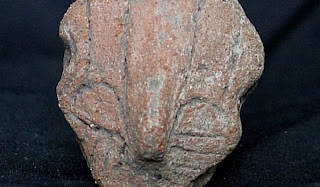The Parţa tell, located about 18 km SW of Uivar one, was situated on the banks of one of the a major branch of the Timiş River and, as it is shown by the 19th century maps drawn before the complete regularization of the river. Prior to channelization, the site was surrounded by a series of meanders channels to the west and south, and by marshy land to the east.
The first Parţa dwellings were hollow pits, which have been taken for hovels and surface dwellings. The houses from this were are small and usually grouped in pairs. This lay-out presumably was determined by the organization of the family and by certain property relations. At the core of the settlement, an isolated house has been uncovered which, due to its central position and due to the fact that it was built above the sanctuaries 1 and 2, has been taken for a possible building for worship. In this first stage, the Parţa settlement was not fortified.
A virtual visit in the settlement.
Further, a settlement planning can be observed, in which the dwellings have been grouped around two structures of similar sizes, erected in the middle of the settlement, so reflecting the social value of the sanctuary as place of manifesting magical rituals. Around the two structures, the houses lied at a certain distance forming a small square. With only two exceptions, all the houses were aligned along the east-west axis, the orientation being dictated, by the strong gusts of the summer storms blown from the west.
The research carried out has shown that the two structures in the small square played a special role for the community life of Parţa. One of the structures, 12.6 m long and 7 m wide, is a sanctuary inside of which altars for offerings, monumental statues and columns once stood. On the northern wall there was an altar-table A which was oriented towards the south. On a clay socket stood an idol bust. In the western part, guarded by two posts, lay altar–table B. Inside the altar, several flint blades which were used for sacrifices were discovered. In the eastern part lay altar C, and at the center of the sanctuary there stood a clay column.
The exterior shows symbolic elements as the Moon and the Sun, the sacred hand grinding mill – which intensifies the magical power of the place. The Neolithic sanctuary from Parţa, the construction, which was favored by the existence of a strong religious, economic and social center, reflects the transmission of basic elements necessary for the creation of a spiritual-magical space according to the beliefs and rituals of that time, transmitted from one prehistoric civilization to another, originate from the latest Neolithic settlements – ancient cultural centers; meanwhile becoming traditional.
To the south of sanctuary 1 lay a structure of similar size that might have fulfilled a social function and namely that of “the house of the tribe”. A fortification system also was built into this level of habitation and was made up of four parallel ditches, lined inwards by four palisades that protected the settlement from the west, north and east sides.
Beginning with these elements that are part of the expression of the important place held by the religious space in the life of the human communities, built from resources of nature – as wood, clay, different vegetal materials, rock – which are crossed on magical symbols, we reach the recognition of all these during historical periods accurately maintained by the local popular tradition. Like the maintenance of the tradition of using natural materials as raw materials in the construction of different buildings and religious places, other practices, rituals and object have been maintained, which can be found nowadays in the popular tradition.
Sources: Muzeul Banatului, European Virtual Museum.
Tour in Batistei area – Sunday 31 August
1 day ago



















